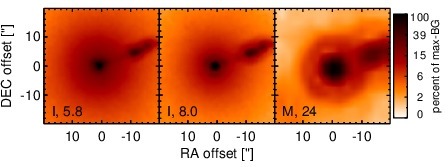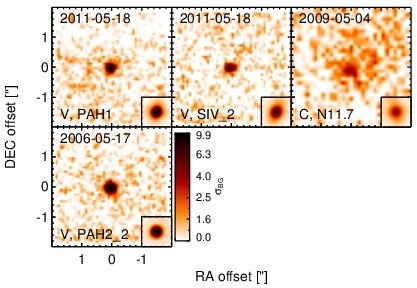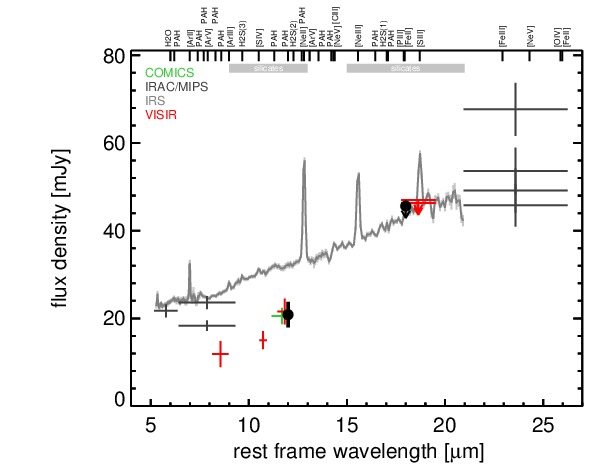Sasmirala Individual Information for M87
Description
M87 is the central giant elliptical galaxy in the Virgo cluster at a distance of D = 16.7 ± 2.6 Mpc with a FR I radio morphology, a radio-loud LINER nucleus [veron-cetty_catalogue_2010] and a prominent jet visible at all wavelengths (see [meisenheimer_synchrotron_1996] for a summary on the jet properties). It contains one of the most massive black hole of the local galaxy population (log MBH∕M⊙ = 9.82 ± 0.03; [gebhardt_black_2011]). The first MIR photometry of M87 was attempted by [kleinmann_observations_1970] but the nucleus remained undetected in N- and Q-band. The first successful detection was achieved by [rieke_infrared_1972] in N-band while the jet still remained undetected [kinman_optical_1974]. Additional N-band photometry of the nucleus was obtained over then next years by [rieke_infrared_1978], [puschell_nonstellar_1981], [heckman_infrared_1983] and [impey_infrared_1986]. Over the course of this decade, the four different measurements with small apertures show an apparent variation of ~ 30% around the median flux. Note that the intrinsic variation probably is much smaller because of the calibration uncertainties, the different measurement methods and filter band-passes. After IRAS, also ISO/ISOCAM imaged M 87 in various MIR filters detecting both the nucleus and the jet [siebenmorgen_isocam_2004, xilouris_dust_2004]. The first subarcsecond MIR imaging of the nuclear region was performed with Keck/LWS in 2000 [whysong_hidden_2001, whysong_thermal_2004] and Gemini/OSCIR in 2001 [perlman_deep_2001], in which a compact nucleus and several jet knots was detected. The same morphology is also seen in the Spitzer/IRAC and MIPS images in addition to diffuse elliptical host emission embedding nucleus and jet (see also [perlman_mid-infrared_2007, shi_thermal_2007]). Two epoch of IRAC 8.0 μm images (2005 and 2008) and four epochs of MIPS 24 μm images (2004, 2005, 2008 and 2009) are available and interestingly show different fluxes for the nuclear component. Because we measure the nuclear component only, our IRAC 5.8 and 8.0 μm and MIPS 24 μm fluxes are in general much lower than in [shi_thermal_2007] and [temi_spitzer_2009], while the nuclear MIPS 24 μm flux of the former work is consistent with ours. Note that the Spitzer/IRS LR staring-mode spectrum from 2005 matches the corresponding IRAC photometry. It shows weak silicate emission and a red spectral slope in νFν-space but no PAH features (see also [bressan_spitzer_2006, perlman_mid-infrared_2007, leipski_spitzer_2009]). The silicate feature gives evidence for the presence of dust in the central ~ 320 pc of M87. [buson_role_2009] however show that this silicate emission can be totally accounted for by the old stellar population.
M87 was imaged with VISIR in the PAH2_2 and Q2 filters in 2006 by [reunanen_vlt_2010] and in two additional narrow N-band filters in 2011 (this work). We also performed COMICS imaging in the N11.7 filter in 2009. Because all these subarcsecond-resolution images are shallower than the OSCIR ones, only the MIR nucleus was detected as a point source in the N-band images, while it remained undetected in Q2. Our nuclear photometry is significantly higher than the values in [reunanen_vlt_2010] but consistent with the previous subarcsecond measurements (see also [asmus_mid-infrared_2011]) and on average ~ 29% lower than the Spitzer spectrophotometry. Unfortunately, the spectral coverage and the precision of the subarcsecond photometry is not sufficient to check the existence of the silicate feature at this resolution. On the other hand, we note that our values fall onto the residual MIR SED from [buson_role_2009] after subtraction of the host emission template. This power-law MIR SED can be well explained only with non-thermal (synchrotron) emission and thus, the existence of a dusty AGN torus in M87 becomes increasingly unlikely.
- [asmus_mid-infrared_2011] D. Asmus, P. Gandhi, A. Smette, S. F. Hönig, and W. J. Duschl. Mid-infrared properties of nearby low-luminosity AGN at high angular resolution . A&A , 536 pp. 36, December 2011.
- [bressan_spitzer_2006] A. Bressan, P. Panuzzo, L. Buson, M. Clemens, G. L. Granato, R. Rampazzo, L. Silva, J. R. Valdes, O. Vega, and L. Danese. Spitzer IRS spectra of virgo early-type galaxies: Detection of stellar silicate emission . ApJL , 639 pp. L55–L58, March 2006.
- [buson_role_2009] L. Buson, A. Bressan, P. Panuzzo, R. Rampazzo, J. R. Valdés, M. Clemens, A. Marino, M. Chavez, G. L. Granato, and L. Silva. The role of the synchrotron component in the mid-infrared spectrum of m 87 . ApJ , 705 pp. 356–360, November 2009.
- [gebhardt_black_2011] Karl Gebhardt, Joshua Adams, Douglas Richstone, Tod R. Lauer, S. M. Faber, Kayhan Gültekin, Jeremy Murphy, and Scott Tremaine. The black hole mass in m87 from Gemini/NIFS adaptive optics observations . ApJ , 729 pp. 119, March 2011.
- [heckman_infrared_1983] T. M. Heckman, M. J. Lebofsky, G. H. Rieke, and W. van Breugel. An infrared and optical investigation of galactic nuclei with compact radio sources . ApJ , 272 pp. 400–410, September 1983.
- [impey_infrared_1986] C. D. Impey, C. G. Wynn-Williams, and E. E. Becklin. Infrared studies of elliptical galaxies. i - an optically selected sample . ApJ , 309 pp. 572–592, October 1986.
- [kinman_optical_1974] T. D. Kinman, G. L. Grasdalen, and G. H. Rieke. Optical and infrared observations of the jet of m87 . ApJL , 194 pp. L1, November 1974.
- [kleinmann_observations_1970] D. E. Kleinmann and F. J. Low. Observations of infrared galaxies . ApJL , 159 pp. L165, March 1970.
- [leipski_spitzer_2009] C. Leipski, R. Antonucci, P. Ogle, and D. Whysong. The spitzer view of FR i radio galaxies: On the origin of the nuclear mid-infrared continuum . ApJ , 701 pp. 891–914, August 2009.
- [meisenheimer_synchrotron_1996] K. Meisenheimer, H.-J. Roeser, and M. Schloetelburg. The synchrotron spectrum of the jet in m87. . A&A , 307 pp. 61, March 1996.
- [perlman_deep_2001] Eric S. Perlman, William B. Sparks, James Radomski, Chris Packham, R. Scott Fisher, Robert Piña, and John A. Biretta. Deep 10 micron imaging of m87 . ApJL , 561 pp. L51–L54, November 2001.
- [perlman_mid-infrared_2007] Eric S. Perlman, R. E. Mason, Christopher Packham, N. A. Levenson, Moshe Elitzur, Justin J. Schaefer, Masatoshi Imanishi, William B. Sparks, and James Radomski. The mid-infrared emission of m87 . ApJ , 663 pp. 808–815, July 2007.
- [puschell_nonstellar_1981] J. J. Puschell. Nonstellar 10 micron emission from E/S0 galaxies with compact radio sources . ApJ , 247 pp. 48–51, July 1981.
- [reunanen_vlt_2010] J. Reunanen, M. A. Prieto, and R. Siebenmorgen. VLT diffraction-limited imaging at 11 and 18μm of the nearest active galactic nuclei . MNRAS , 402 pp. 879–894, February 2010.
- [rieke_infrared_1972] G. H. Rieke and F. J. Low. Infrared photometry of extragalactic sources . ApJL , 176 pp. L95, September 1972.
- [rieke_infrared_1978] G. H. Rieke. The infrared emission of seyfert galaxies . ApJ , 226 pp. 550–558, December 1978.
- [shi_thermal_2007] Y. Shi, G. H. Rieke, D. C. Hines, K. D. Gordon, and E. Egami. Thermal and nonthermal infrared emission from m87 . ApJ , 655 pp. 781–789, February 2007.
- [siebenmorgen_isocam_2004] R. Siebenmorgen, W. Freudling, E. Krügel, and M. Haas. ISOCAM survey and dust models of 3CR radio galaxies and quasars . A&A , 421 pp. 129–145, July 2004.
- [temi_spitzer_2009] Pasquale Temi, Fabrizio Brighenti, and William G. Mathews. Spitzer observations of passive and star-forming early-type galaxies: An infrared color-color sequence . ApJ , 707 pp. 890–902, December 2009.
- [veron-cetty_catalogue_2010] M.-P. Véron-Cetty and P. Véron. A catalogue of quasars and active nuclei: 13th edition . A&A , 518 pp. 10, July 2010.
- [whysong_hidden_2001] D. Whysong and R. Antonucci. A hidden nucleus in cygnus a, but not in m87 . ArXiv Astrophysics e-prints , page 6381, June 2001.
- [whysong_thermal_2004] D. Whysong and R. Antonucci. Thermal emission as a test for hidden nuclei in nearby radio galaxies . ApJ , 602 pp. 116–122, February 2004.
- [xilouris_dust_2004] E. M. Xilouris, S. C. Madden, F. Galliano, L. Vigroux, and M. Sauvage. Dust emission in early-type galaxies: The mid-infrared view . A&A , 416 pp. 41–55, March 2004.
Images

Optical image (DSS, red filter). Displayed are the central 4 arcmin with North being up and East to the left. The colour scaling is linear with white corresponding to the median background (BG) and black to the 0.01% pixels with the highest intensity.

Spitzer MIR images. Displayed are the inner 40 arcsec with North being up and East to the left. The colour scaling is logarithmic with white corresponding to median BG and black to the 0.1% pixels with the highest intensity. The label in the bottom left states instrument and central wavelength of the filter in micron (I: IRAC, M: MIPS).

Subarcsecond-resolution MIR images sorted by increasing filter central wavelength. Displayed are the inner 4 arcsec with North being up and East to the left. The colour scaling is logarithmic with white corresponding to median BG and black to the 75% of the highest intensity of all images in units of sig_bg. The inset image (where present; either bottom or top right) shows the central arcsecond of the PSF from the calibrator star, scaled to match the science target. The labels in the bottom left state instrument and filter names (C: COMICS, M: Michelle, T: T-ReCS, V: VISIR).
SEDs


MIR SED. The description of the symbols in all the SED plots (where present) is the following: Grey crosses and solid lines mark the Spitzer/IRAC, MIPS and IRS data. The colour coding of the other symbols is as follows: green for COMICS, magenta for Michelle, blue for T-ReCS and red for VISIR data. Darker-coloured solid lines mark spectra of the corresponding instrument. The black filled circles mark the nuclear 12 and 18 micron continuum emission estimate from the data (where present). The ticks on the top axis mark positions of common MIR emission lines, while the light grey horizontal bars mark wavelength ranges affected by the silicate 10 and 18 micron features.